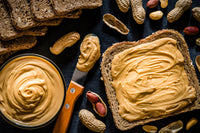By Kathryn Peck / Medically reviewed by Dr. Samantha Ball, DO
I think I might have given birth to the pickiest eater on the planet. He’s a slow eater, tiny-bite taker (Mrs. Piggle-Wiggle, anyone?), but he’s also enormously picky. How picky? A slight discoloration in the cheese atop a pizza is cause for alarm, and getting him to eat a kernel of corn last week made him gag, literally.
He’ll eat macaroni & cheese … as long as it’s shell-shaped pasta.
He’ll happily eat pizza … but he won’t dare touch a pizza bagel.
He’ll eat a grilled cheese sandwich … as long as it’s yellow American cheese, the crusts are off, and it’s preferably cut in the shape of a dinosaur.
Sounds like a power struggle, right? I have tried to serve him the same meals that the rest of the family eats, but he’d prefer to eat nothing. I tell myself, “if he’s hungry, he’ll eat.” But after a few days of exhausting efforts, mind games, and constant worry, I give in and offer him yogurt and cheese for dinner. Bribery doesn’t work, nor does the promise of ice cream for dessert.
I tell myself, “if he’s hungry, he’ll eat.” But after a few days of exhausting efforts, mind games, and constant worry, I give in and offer him yogurt and cheese for dinner.
Experts say that picky eaters show their picky-eater colors between the ages of 15 months and 4 years old. According to healthychildren.org, children age 1-3 years need about 40 calories for every inch of their height. For instance, a toddler who measures 30 inches should be taking in an average of about 1,200 calories a day (this of course varies with each child's build and activity level).
When I spoke to our pediatrician about his eating habits, instead of talking about what he isn’t eating, I listed the things he is eating, and they actually sounded not-too-bad. Milk, yogurt, hummus, cheese, fruit, cereals, and the occasional chicken nugget. But some key categories were missing, particularly fiber and proteins, which point to key nutrients like iron, magnesium, and potassium that are missing from his diet. And now that he’s entering his school-age years, it’s time to get more serious about his eating habits, I’m afraid.
And now that he’s entering his school-age years, it’s time to get more serious about his eating habits.
If you have a picky eater on your hands and, like me, have exhausted your efforts for the moment, here are a few ways to sneak in a few extra vitamins, minerals and fiber, without them knowing.
- Mix the yolk of a hard-boiled egg with your little one’s macaroni and cheese. Eggs are a protein powerhouse, and half of the protein is found in the yolk alone. The yolk of a large egg contains about 55 calories, while the white part contains just 17 calories. Yolks are also high in omega-3 fatty acids and other key vitamins and minerals.
- Add a few leaves of spinach to an otherwise fruit smoothie. If you already have blueberries in the smoothie, it’ll better disguise any hint of spinach’s presence. This leafy green vegetable may be one of the most nutritious for kids, high in iron and vitamins A, K, and C.
- Add a tablespoon or two of carrot juice to orange juice in the morning. This isn’t enough to change the color, drastically, nor will it diminish the sweet flavor of orange juice. Carrots are rich in beta-carotene, an essential nutrient for healthy growth in children. Carrots are also high in vitamins, minerals (like calcium and iron), and dietary fibers.
- Don’t overlook peanut butter, it’s loaded with protein and healthy fats, and a great way to sneak in some extra calories for picky eaters. It’s a great dip for vegetables, fruit, and crackers, and if blended with milk and yogurt, it perfectly hides any green vegetables you might try to sneak in.
- Make zucchini bread or zucchini bread muffins, and to avoid the dreaded green specs that are visible only to a toddler’s eye, peel the zucchini first or swap zucchini out for yellow summer squash. Zucchini is an excellent source of manganese and vitamin C, as well as magnesium, vitamin A, dietary fiber, potassium, copper, folate, and phosphorus.
- Swap oats for some flour in baked goods. It’s surprising, but oats contain a good amount of protein – ½ cup of dry oats has about 6 grams of protein. When making quick breads or muffins, try substituting old-fashioned oats for up to ⅓ of the flour called for in the recipe. (You will need some flour, however, because oats don’t contain the gluten needed for most muffins or quick breads.)
- Add pureed vegetables to your regular pizza sauce. You’ll cover the sauce with cheese, which also helps to hide possible specs of green. Try zucchini, carrot, bell pepper, onion or spinach (1 cup chopped vegetables = 15 oz can of pizza sauce).
- Add pureed sweet potatoes, pumpkin or zucchini to cookies. Look for recipes like Chocolate Chip Zucchini Cookies or Carrot, Apple, & Oat Breakfast Cookies.
One thing you don’t want is to get sucked into thinking the baby food aisle at the grocery store is a way to sneak in healthy foods. Smoothie pouches, breakfast cookies, cereals, and those cute little yogurt melts (guilty!) are actually packed with sugar. The healthier (and cheaper) finger foods for your baby are often not in the baby food aisle, and steering clear of this aisle also teaches little ones that snacks should not be from processed foods in a jar or pouch.
-
Please note: This is for educational and informational purposes only and is not meant to substitute individual medical advice. For specific and individual advice, always talk to your doctor.
About the author: Kathryn is the owner of Bicycle Pie and mom of 4 little ones. Also a writer, editor, and former owner of one of Boston's premiere baby boutiques, she continues to write about motherhood, children's products, family life, and all other things that test our skills and patience as parents.
About the reviewer: Dr. Samantha Ball, DO, is a pediatrician, cat mom, and advocate for children’s overall health and wellness. She is continually focused on supporting families through all stages in a realistic and evidence-based way. In addition to practicing medicine in Georgia, she shares experiences and her perspectives on topics including parenting tips, mental and physical health, and how to navigate the unexpected challenges that come about when raising kids.
Photo credit: iStock.com/pinstock




